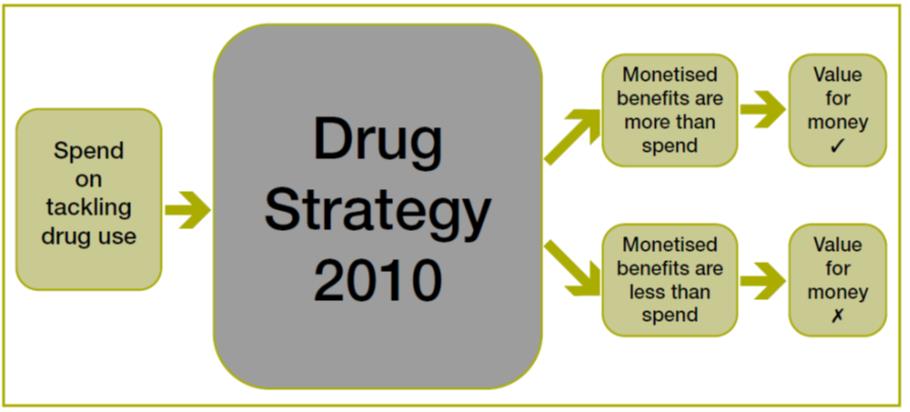Pike, Brigid
(2014)
Drug strategy to be evaluated.
Drugnet Ireland,
Issue 49, Spring 2014,
pp. 5-6.
In December 2013 the Home Office published an evaluation framework,1 developed to assess the effectiveness and value for money (VFM) of the English and Welsh Drug Strategy 2010, which expires in 2015.2
Reason for the evaluation
While noting that data are available to monitor trends in drug use and also the numbers leaving drug treatment drug free, the evaluation framework document argues, ‘… it is not sufficient only to consider changes in these data as this does not enable us to attribute changes, whether they be good or bad, to the effects of the Strategy (i.e. we would not be able to prove that it was the Strategy that caused any changes in drug use or recovery)’ (p.8). The document goes on to state that, in order to robustly assess the effectiveness of the drug strategy in meeting its aims, it is necessary to evaluate the impacts of the programmes and interventions being undertaken as part of the strategy.
The scope of the evaluation
The Home Office states that the evaluation must be capable of assessing whether the drug strategy has met the overarching objectives and aims contained in the strategy document. While these are non-quantitative and aspirational, the Home Office argues that value for money will have been achieved if the money spent on tackling drug use is less than the monetised benefits resulting from the drug strategy (see accompanying figure).

Source: HM Government (2013) Drug strategy 2010 evaluation framework, p.8
How will the evaluation be undertaken?
The framework document outlines the steps in the evaluation, some of which have already been completed.
1. Drug-related programmes and interventions have been divided into five activity groups, each of which links to one or more of the objectives and aims set out in the 2010 drug strategy and where common aims and measurement can be applied. The five groups are early interventions, education and information approaches, treatment, non-treatment rehabilitative activity, and enforcement. A ‘logic model’ has been developed for each of these activity groups, outlining how they should operate to achieve their aim.3
2. A meta-evaluation approach4 will be used to combine the results from different evaluations within each activity group. Where sufficient evidence is available, separate VFM estimates will then be calculated for the five activity groups. The Home Office acknowledges that there are considerable gaps in evidence, and states that one of the intentions of the evaluation is to stimulate debate about how to fill these gaps.
3. Having gathered data and estimated direct government spend on tackling drug use for each of the five activity groups, the direct return on investment (RoI) will then be assessed. This will be more difficult for some interventions than for others. For example, it has long been problematic to identify the drug-related proportion of enforcement spend (such as police activity), and of the spend for interventions which are not specifically aimed at drug users, such as early interventions. The evaluation framework document discusses how it proposes to tackle these challenges in some detail.
4. Both drug-specific benefits and wider benefits relating to health, crime and employment will be identified with the help of the logic models. The scale of these benefits, and the extent to which they were caused by Drug Strategy 2010, will then be evaluated. Evaluating benefits will be made more complex in certain areas, such as the non-treatment rehabilitative activity group, due to the outcomes and benefits of one intervention likely overlapping with the outcomes of another. Any overlap will need to be recognised and benefits shared appropriately across the activity groups.
The evaluation of national drug strategies has been the subject of considerable debate across Europe and the international drug policy community.5 In the introduction to this evaluation framework document, the Home Office stresses that evaluating the drug strategy is a work in progress, a learning experience, which is likely to evolve as new information and evidence emerge.
3. According to the Drug strategy 2010 evaluation framework, ‘Logic models describe the theory, assumptions and evidence underlying the rationale for a policy, by linking the intended outcomes (both short and long-term) with the policy inputs, activities, processes and theoretical assumptions’ (p.12).
4. According to the Drug strategy 2010 evaluation framework, meta-evaluation is ‘the synthesis of results from individual evaluations falling within the same activity group (e.g. enforcement), to provide an overall estimate’ (p.11).
